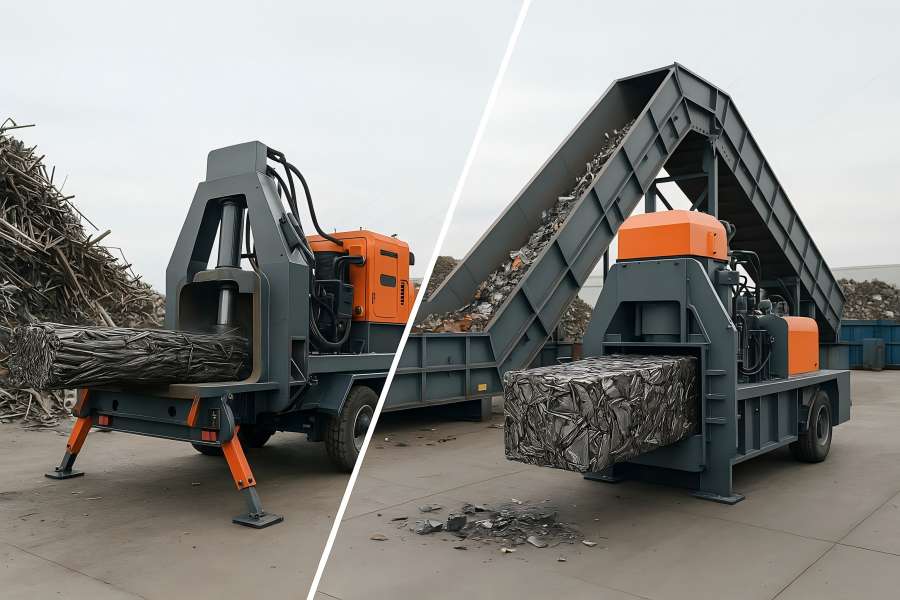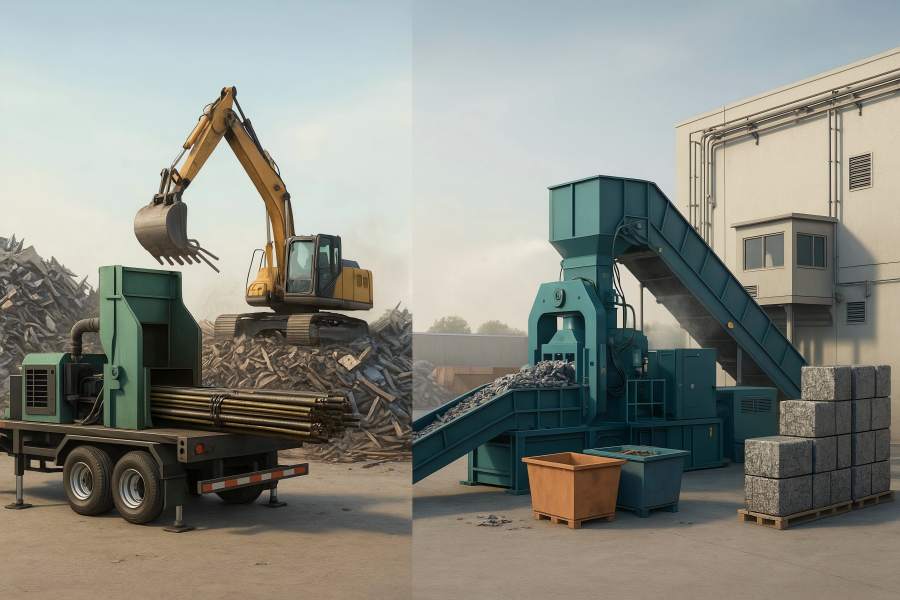If you process a steady scrap stream from offcuts, demolition steel, and mixed nonferrous, baling quickly lifts margin. Denser bales cut freight, stabilize downstream processing, and make inventory predictable. The right machine depends on your operation. Some gain more from a mobile self contained baler that goes to the scrap, while others need a high throughput stationary system tied to a fixed yard flow.
This buyer’s guide focuses on commercial impact across capital allocation, throughput, labor, compliance, uptime, and total cost of ownership (TCO).
What “Mobile” and “Stationary” Really Mean
Mobile metal balers (often “baler-loggers,” sometimes with shear capability) are skid- or trailer-mounted, diesel-powered machines designed to be transported between jobs or repositioned around a yard.
They compress material within a self-contained chamber; some models log long bundles for easier transport; others produce traditional bales. Power and hydraulics are packaged on board, with outriggers for stability.
Stationary metal balers (single-ram, two-ram, shear-baler, or channel balers) are permanently installed in a yard. They typically run on electric motors driving hydraulic power units (HPUs).
These systems integrate with in-feed conveyors, pre-shredders or shear lines, dust control, and auto-tying systems—forming the backbone of a fixed processing flow.
Commercial Use Cases
Mobile makes sense when:
- You process dispersed, irregular scrap sources (construction/demolition sites, remote clean-ups, satellite yards).
- You need short-term on-site densification to avoid hauling loose scrap.
- Your yard lacks adequate power or you face utility lead times delaying installation.
- You do contract baling as a service (revenue from mobility itself).
Stationary wins when:
- You have predictable, high volumes in one location.
- You want tight integration with upstream and downstream equipment.
Electric power is available and cheaper per ton than diesel. - You prioritize lowest unit cost, maximum automation, and consistent bale specs.
Key Performance Metrics and Typical Ranges
Ranges vary by material, bale format, and model. Use these as directional anchors for vendor discussions.
Throughput (ferrous):
- Mobile: ~3–15 t/h (peaks to 20 t/h with ideal feed, logging mode)
Stationary: ~10–50 t/h (high-end shear/channel lines above 60 t/h)
Throughput (non-ferrous mix):
- Mobile: ~1–6 t/h
- Stationary: ~5–25 t/h
- Bale/log density (ferrous): ~1.2–1.8 t/m³
- Bale/log density (non-ferrous): ~0.6–1.2 t/m³
Ram force:
- Mobile: ~80–300 tons
- Stationary: ~150–1,000+ tons (depending on architecture)
Cycle time:
- Mobile: ~60–180 s (logging longer)
- Stationary: ~20–90 s (faster with multi-ram systems and accumulators)
Installed power/fuel:
- Mobile: ~100–350 kW equivalent (diesel), ~8–25 L/h fuel burn
- Stationary: ~90–400 kW electric (HPU total), energy ~8–20 kWh/t typical
Chamber size (WxHxL):
- Mobile: ~0.6–1.0 m × 0.5–0.8 m × 4–6 m
- Stationary: wide variation; often larger and reconfigurable with liners
Labor:
- Mobile: 1 operator + 1 material handler common
- Stationary: 1 operator with higher automation potential (auto-tie, conveyors)
Comparison Table: Commercial Factors
| Factor | Mobile Balers | Stationary Balers | Buyer Notes |
| Acquisition cost | ~$350k–$900k | ~$800k–$2.5M+ | Stationary lines scale higher with automation and shear capability. |
| Civil works | Minimal to low | Moderate to significant | Stationary needs pads, power, sometimes building modifications. |
| Power | On-board diesel | Yard electric (3-phase) | Electric cost/ton typically lower; diesel adds flexibility. |
| Mobility | High (road-legal transport) | None | Mobility can be monetized via contract work. |
| Setup time | Minutes to hours | Weeks to months | Stationary requires utilities, commissioning, integration. |
| Throughput ceiling | Moderate | High to very high | Stationary dominates where tonnage is the bottleneck. |
| Bale uniformity | Good (varies with feed) | Excellent | Two-ram/channel systems produce very consistent bales. |
| Integration | Limited | Strong | Conveyors, pre-sort, auto-tie, dust suppression, ERP. |
| Unit cost/ton | Moderate | Low at volume | Electric + automation drives cost down with scale. |
| Maintenance | Field-service oriented | Planned PM windows | Stationary shops can standardize parts and PM workflows. |
| Noise/emissions | Higher (diesel) | Lower (electric) | Environmental permits favor stationary electrified lines. |
| Permitting | Transport + site use | Electrical + environmental | Local rules vary; check noise, fluid containment, stormwater. |
| Residual value | Strong in niche markets | Strong overall | Both retain value; stationary depends on removal cost. |
| Training | Operator + transport skills | Operator + system skills | Stationary may need PLC/HMI familiarity. |
Total Cost of Ownership (TCO)
Capex
- Machine purchase or lease
- Site prep (pad, drainage), electrical service (for stationary), transporting a mobile unit to first job
Opex
- Energy: diesel (mobile) vs. electricity (stationary)
- Labor: operator(s), material handlers
- Consumables: bale wire/strapping, hydraulic oil and filters, wear liners, blades/knives (shear-baler)
- Preventive and corrective maintenance: seals, hoses, pumps, cylinders, sensors
- Logistics: moving a mobile unit between sites (permits, tractors, escorts where required)
Hidden costs and risks
- Downtime (spares availability, vendor service response)
- Quality leakage (bales out of spec → downstream penalties)
- Safety and compliance (fluid containment, lockout-tagout, noise, emissions)
- Training (operator turnover, multi-shift coverage)
Residual value
- Strong brands and well-documented service history boost resale.
- Stationary line relocation costs can erode resale value; mobile units are simpler to trade.
Worked ROI Scenarios
These simple models use conservative, round numbers. Replace with your actual rates and volumes.
Scenario A: Mobile Baler for Distributed Demolition Work
- Capex: $650,000 (diesel baler-logger)
- Annual volume: 10,000 t (mixed ferrous), dispersed across job sites
- Current method: Haul loose scrap, payload average 10 t/load
- With baling: Bale/log density lifts payload to 18 t/load
- Freight cost: $4.50/mile, average 50 miles per haul, 2 hours per round trip, $90/hr driver
- Energy & consumables: Fuel 15 L/h, 8 h/day × 220 days, diesel $4.00/gal equivalent → ~$28,000/yr
- Wire/consumables: $5/t → $50,000/yr
- Maintenance: $45,000/yr parts & PM
- Operator + handler: $180,000/yr loaded
Freight savings:
- Before: 10,000 t / 10 t per load = 1,000 loads
- After: 10,000 t / 18 t per load ≈ 556 loads
- Loads eliminated ≈ 444
- Cost per load: miles (50)×$4.50 = $225 + driver time (2 h × $90) = $180 → $405/load
- Annual freight savings ≈ 444 × $405 = $179,820
Net EBITDA uplift (year):
- Freight savings: +$179,820
- Less fuel: −$28,000
- Less wire: −$50,000
- Less maintenance: −$45,000
- Less labor delta (assume same handlers as before, add 1 operator): −$90,000 incremental
- Net ≈ −$33,180 (on freight alone)
But mobile projects often unlock revenue via on-site contracts and tip-rate improvements because sites become serviceable. If the baler enables only $5/t higher net price (revenue or avoided penalties):
- 10,000 t × $5/t = $50,000
- Revised net ≈ +$16,820 per year (plus strategic access to jobs you otherwise couldn’t serve)
Payback sensitivity: If annual volume rises to 15,000 t or the payload improvement hits 20→30 t/load on some materials, payback accelerates sharply. Conversely, if hauling distances are short, freight savings shrink—justifying mobile only when it also brings new revenue.
Scenario B: Stationary Two-Ram Baler for a Core Yard
- Capex: $1,600,000 (two-ram with auto-tie, conveyor, HPU)
- Annual volume: 40,000 t (mix of ferrous and non-ferrous)
- Electric cost: $0.12/kWh, energy 12 kWh/t → $57,600/yr
- Wire/consumables: $4/t → $160,000/yr
- Maintenance: $140,000/yr
- Operator & support (automation reduces headcount): $220,000/yr
- Bale density enables freight improvement worth: $6/t net
- Downstream price improvement from spec consistency and reduced rejects: $4/t net
Annual gains: (6 + 4) × 40,000 = $400,000
Annual costs: Energy $57.6k + consumables $160k + maintenance $140k + labor $220k = $577.6k
If baseline handling costs without baling were higher by $20/t (extra yard moves, truck cube loss, penalties), stationary baling avoids $800,000 in costs, flipping the economics:
- Avoided baseline cost: +$800,000
- Plus price/freight improvement: +$400,000
- Less operating costs: −$577,600
- Net ≈ +$622,400/yr, giving a simple payback ≈ 2.6 years (before tax benefits and depreciation).
Takeaway: Stationary lines shine when volume, power price, and integration allow you to “industrialize” the yard and squeeze cost/ton down.
Operational Considerations
Feedstock Mix & Prep
- Long, awkward shapes (beams, rebar bundles) often process faster as logs on mobile units at source, avoiding yard rehandling.
- Mixed non-ferrous sorted via conveyor and bunker lines favors stationary two-ram baling for spec-tight, uniform bales.
Site Layout & Material Flow
- Stationary: place the baler to minimize loader travel and double-handling. Conveyors pay back quickly if they eliminate loader hours.
- Mobile: plan set-ups for safe loading (ramps, level ground, outriggers) and fluid containment.
Energy Strategy
Electricity generally beats diesel on $/ton. If you have low-tariff power or rooftop PV offsets, stationary economics become compelling.
Uptime & Service
- Mobile work is often far from your shop; spare kits (seals, hoses, sensors) and remote diagnostics mitigate field downtime.
- Stationary lines benefit from vendor predictive maintenance options (oil cleanliness monitors, pressure pulsation alarms, motor temp trending).
Compliance & Community
- Stationary: oil containment, noise abatement, and dust control may be mandatory; budget for enclosures and pads.
- Mobile: local rules for fueling, spill kits, and working hours at customer sites apply; transport weight/size permits may be needed.
People & Training
- Cross-train loader and baler operators; standardized SOPs reduce bale variability and accidents.
- PLC/HMI literacy matters more on stationary systems; invest in vendor training days.
Practical Tips to Maximize ROI
- Right-size the chamber: Too small spikes cycle time; too big wastes force and wire.
- Match wire to density: Overspec wire burns cash; underspec risks bale failure penalties.
- Standardize recipes: Save pressure limits, dwell times, and tie counts per material.
- Keep oil clean and cool: ISO cleanliness targets and heat rejection capacity are cheap insurance for pumps and valves.
- Instrument the line: Log cycle counts, peak pressures, and oil temps; schedule PM by data, not guesswork.
- Balance loaders and in-feed: A starved baler is wasted capex; an overfed baler becomes a maintenance headache.
- Train, then retrain: The same machine can run 10–20% faster (and safer) with consistent operators and clear SOPs.
- Negotiate service SLAs: Include guaranteed response times and parts stocking in the purchase.
Common Mistakes to Avoid
- Buying on tonnage rating alone: Chamber geometry, cycle logic, and feed style matter just as much.
- Ignoring bale specifications: Downstream mills may require specific dimensions or density; missing these erodes price.
- Underestimating power: For stationary lines, verify utility capacity and lead times early; add margin for future growth.
- Skipping containment and pads: Hydraulic spills and settling equipment turn into expensive rework and fines.
- Assuming diesel always costs more: At remote sites, diesel may be the only workable option—and faster mobilization can win jobs.
- No spare kits: A $2,000 hose kit on the shelf can prevent days of downtime.
Recommendations
Choose mobile when your competitive edge is going to the scrap—serving remote jobs, bundling long sections on site, or spinning up satellite collections without waiting on utilities. Treat mobility as a revenue line, not just a convenience, and price contracts to recover travel, permits, and field service risk.
Choose stationary when you can industrialize the yard: steady volumes, electric power, conveyors, auto-tie, and predictable downstream specs. The combination of lower energy cost/ton, higher throughput, and tighter quality control typically yields the best long-term EBITDA and 2–4 year payback at scale.
If uncertain, pilot with mobile to quantify densification and logistics savings, then graduate to stationary when volumes and power availability justify it. Many profitable yards run both: a stationary core for base load and a mobile unit for remote harvest and surge capacity.





